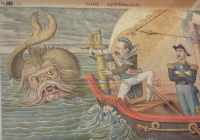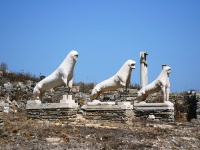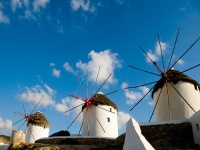Things to do in Mykonos
Fun on Mykonos goes beyond good shopping and a cosmopolitan nightlife. In particular, history buffs and mythology fans will find much to their liking. The Archaeological Museum, the Aegean Maritime Museum and the Folklore Museum are great places to start. The 15th-century Church of Panagia Paraportiani is another must-see attraction. Located near the harbour, it features four churches on the ground and one built on top of them. It's the most photographed church on the island.
Visitors should also look out for Mykonos' official mascot, Petros the Pelican, while strolling down by the harbour. The trademark 16th-century windmills are worth seeing as well. The 18th-century Monastery of Panagia Tourliani and the Monastery of Paleokastro are tremendous religious sites, and both are in Ano Mera.
A day trip to the UNESCO World Heritage Site of Delos Island is an absolute must, as the mythological birthplace of Artemis and Apollo is a national museum, and has famous archaeological sites. Little Venice is enchanting, with its characteristic balconies hanging over the sea's edge. Mykonos' beaches are popular for a reason; some are nudity-friendly.

Aegean Maritime Museum
The Aegean Maritime Museum is a non-profit institution. Located on the island of Mykonos, it collects, studies and promotes Greek maritime history and tradition.
Aegean Maritime Museum
The Aegean Maritime Museum is a non-profit institution. Located on the island of Mykonos, it collects, studies and promotes Greek maritime history and tradition.
Visitors can enjoy wonderful models of pre-Minoan ships, a superb collection of old maps and documents, navigational instruments, as well as rare coins and engravings. The museum is also proud of its three 'living' historical exhibits, namely the 'Armenistis' lighthouse, the Perama-type sailing boat 'Evangelistria', and the cable-laying steamship, 'Thalis o Milissios'.
Along with these treasures, visitors can stroll through a picturesque garden courtyard and admire anchors, the top of the old Mykonos lighthouse, and replicas of drowned sailors' gravestones. The museum gives fascinating insight into the island's history, and is a good stop for the entire family.
Website www.aegean-maritime-museum.com/en/home-en/

Delos
The island of Delos is a must for history buffs and lovers of Greek mythology, as the UNESCO World Heritage site is one of Greece's most important mythological, historical and arch…
Delos
The island of Delos is a must for history buffs and lovers of Greek mythology, as the UNESCO World Heritage site is one of Greece's most important mythological, historical and archaeological locations. People have lived on Delos since the 3rd millennium BC, with the island serving as a sacred site for multiple religions, cults and sects over the centuries. It has also played a role in numerous historical events and been the subject of myths and prophecies. Archaeological excavations on Delos are extensive and ongoing, uncovering many valuable buildings and artefacts. Some of these are on display in the Archaeological Museum of Delos. Visitors should look out for the circular Sacred Lake, the Minoan Fountain, the Terrace of the Lions, and several impressive ancient buildings and temples.

Mykonos Windmills
The white windmills are iconic on Mykonos island and are visible from every part of Chora (also often called Hora) village. Those interested in the mechanics of windmills (once suc…
Mykonos Windmills
The white windmills are iconic on Mykonos island and are visible from every part of Chora (also often called Hora) village. Those interested in the mechanics of windmills (once such common and important technology and now seldom seen) will be captivated by them and children also tend to be enthralled.
There's a reason for everybody to take a stroll to the famous windmills, though, and that's the spectacular views from the hill, which is best visited in the late afternoon towards sunset, and overlooks the whole town of Chora and the harbour too. There are 16 windmills left on Mykonos and seven of these stand on the hill at Chora. Some of them were built by the Venetians in the 16th century, but construction continued into the 20th century, so they are not all that old, or have been renovated since then.
They were once an important means of survival and income for the inhabitants of the town, and were used primarily to mill wheat. They are white-walled, thatched-roofed windmills and are rather mesmerising, although they are now out of use. It's a great spot for photographs and picnics and one of the mills has been turned into a small museum. There's no need for directions as the windmills are probably the first thing visitors will see when they enter the village or the port.



